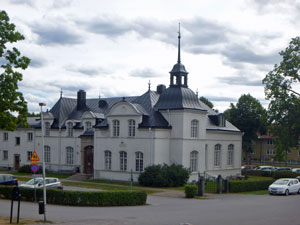| Cycling the Gota Canal |
Getting There |
Upon being discharged from Copenhagen's Amager Hospital, we caught a taxi straight to the train station and took a re-scheduled afternoon train across the famous "Bridge" to Malmo in Sweden, as large grey clouds billowed over the leaden sea below and rain squalls swept by. Goodbye Denmark - I'm sorry that we didn't see a bit more of you, but I am impressed with your Public Health Service. The next train from Malmo, a blast from the past with old bench-seated compartments, rattled us northwards - out of the rain and into the Swedish sunshine, as we crossed this flat landscape of golden wheat-fields, russet-red farm buildings, forests of birch, beech and assorted conifers, the odd lake and a series of small towns and villages, all of which we stopped at. Our delay in leaving had found us on the local express. Still, it was a pleasant journey, once you discount the periodic abdominal cramps and quick trips to the tiny train loo - no, even though the final blood test pointed in the right direction, my symptoms had not yet gone completely. |
||
 The old windmill at Korskullen |
 First glimpse of the Gota Canal |
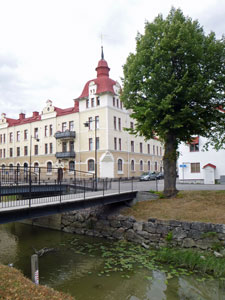 Buildings of Söderköping |
Disembarking at Norrköping, we hopped from train to local bus and reached our destination of Söderköping, as the last rays of sunshine were disappearing in the west. We had a small "cabin" at Korskullens Camping, booked because this would be where we end our next cycle tour. Korskullens is indeed a retro campground and you could imagine it in its hey-day of the 50s and 60s with lines of canvas tents and the tiny but quaint wooden cabins. However, today, canvas has been replaced by rows of modern plastic and aluminium campervans and caravans, and the camp is now seriously under-amenitised. However, enough whinging - it was home for the next two nights and the bed was very comfortable. At the moment, that was all I really wanted. |
The next day was listed as a "rest day", which usually means I hadn't yet decided what we would do. However, it turned out to be just that - a rest day. Time to enjoy a coffee on the deck, do a bit of washing and crosswords, see what the local supermarket held, listen to a group of Swedish folk musicians that set up a concert on the small knoll behind our camp, and explore the old buildings and canals of Söderköping in the evening light. |
 Early 1700s farm building |
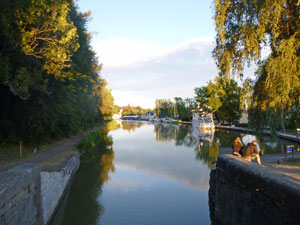 Evening light on the Gota Canal |
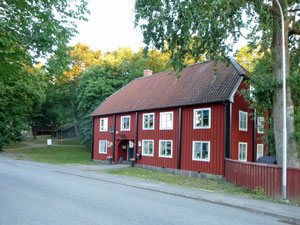 Present day hostel - built in the early 1700s |
Korskullens, itself is fascinating. On, and behind, the knoll, away from the camping area are a series of old wooden buildings constructed around 1700. Pride of place would go to the windmill on top of the knoll, standing proudly in its russet-red timber cladding. It was a very necessary rest-day, as tomorrow we are to start our 3-day cycle down this part of the Gota Canal and, "by hell or high water", I am going to do it. |
||
|
|
Day 1 - Motala to Glasbruket (25 km) |
Glasbruket is a hostel comprising a number of old buildings set in lovely grounds on a thin strip of land between the Gota Canal and the fast-flowing true channel of the Motala River. We were in the Yellow Building and it was good to finally reach here in mid-afternoon and find our comfortable room. I say good because we almost didn't. With a few hundred metres to go, I stopped on the edge of the canal to take a photo of an elegant two-masted vessel pushing slowly upstream. When I went to dismount, both legs froze in painfully parallel postures - both thigh muscles had gone into cramp at the same time. It was both painful and inelegant. However, with the fair Nello's help, I managed to "re-fold" them, apply some stretching and reach the hostel. If one were of the "I told you so" disposition, one might say that's what happens when you ride after 10 days of food poisoning symptoms. Luckily, the Fair Nello isn't, and she quickly got out the rehydration salts that set me on the path to recovery. It was disheartening though, only 25 km of easy riding on flat canal banks and in the gently rolling Swedish countryside next to it, and I had been done in. |
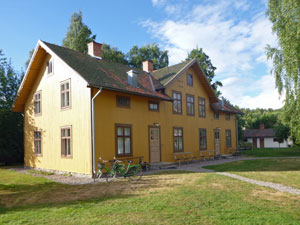 Our accommodation at Glasbruket |
Earlier this morning, we had hopped on the bus to Norrköping and then the modern local train to Motala to pick up our bikes for the Gota Canal Trip. Compared to the friendly efficiency of the Danish Cycling Company of last week, the vibe here was a bit underwhelming. Panniers provided for a 3-day trip - why? We hired two sets. Repair kit - clearly an unnecessary luxury. Our information package contained nothing specific to the route of this self-guided tour, just some brochures for local attractions and a couple of large-scale maps of general guidance value only (that said, following a canal, you can't go too wrong and the route away from it was all on quite country roads that were well marked). The bikes were heavy "old-ladies shopping bikes" with a rear back-step brake (I haven't used one of these in 50 years), one cluster of gears (given to slip) and a front levered brake (which is all I ended up using). In the end they were fine for pottering along the flat canal path, but made for hard going as soon as there were undulations. We decided we were going to enjoy this trip, regardless - loaded the panniers and rode off to have coffee next to where the Gota Canal flowed out of Lake Motala. By the time we finished, our spirits were up and the sun was shining. |
||
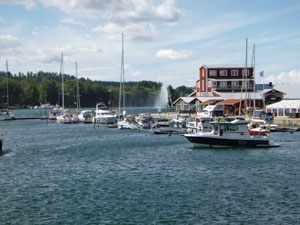 The start - the marina on Lake Motala |
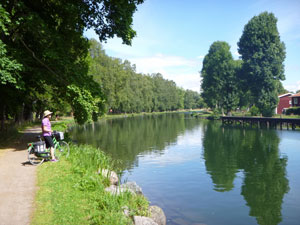 Lovely day for a ride on the Gota Canal |
 The first (of many) boats to pass by |
It was great to be out and about again, pottering down the gravel path as we followed the canal down from Lake Motala beneath the shade of its tree-lined shores. This soon brought us to the locks of Borenshult, where a series of five locks lift the canal level 15m from Lake Boren. Luckily for us, a group of yachts were going through, so we could watch the whole lock process in action. It can get a bit tense in the churning lock, as water rushes in and the skippers have to keep re-tensioning tie-lines as the level rises - there was almost one in-lock clash of boats. |
|||
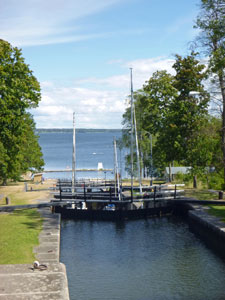 The locks at Borenshult |
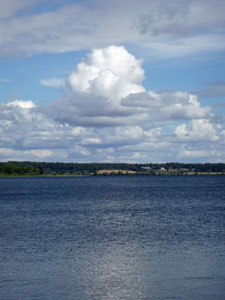 Clouds over Lake Boren |
 Yachts being lifted in a lock |
 Crossing the Motala River |
We crossed the canal here, doubling back a bit to take a bridge over the small ravine through which flowed the true course of the Motala River (but too quickly for navigation in the 1800s) and then found ourselves passing an ICA supermarket - a chance to stop and buy some bread, salad and fruit for lunch later on. |
||
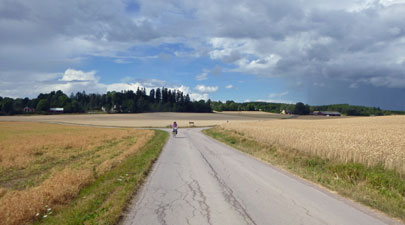 On a rural road south of Lake Boren |
The Gota Canal Cycle Path turned inland from here, to leave the town and follow a series of quiet sealed and gravel roads across the rolling farmland landscape south of Lake Boren. We were exposed to the strong south-westerly wind, but that was good - we were heading east. |
 Rainclouds approaching |
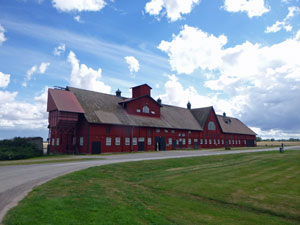 The big red barn |
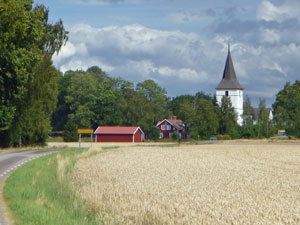 Entering the village of Ekkerbyborna |
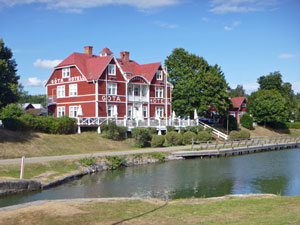 The old wooden Gota Hotel |
With bands of big grey cloud scudding across, we pedalled on past clusters of red wooden farm buildings and through golden wheatfields, separated by patches of forest. The wind wafted across waves of rich rural smells as we passed the farms. Reaching one very large (and scent-free) red-walled barn, we stopped for our lunch break with its pleasant view ahead to the distant white-steeple of a country church across the wheat-fields. |
||
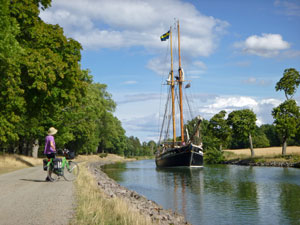 Two-master cruising up the canal |
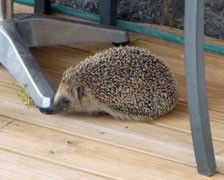 The dinner guest |
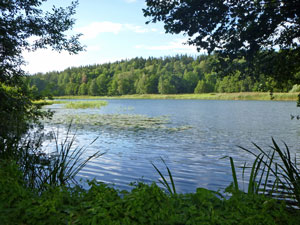 Pondage on the Motala River near Glasbruket |
The after-lunch riding continued in the same vein, passing a series of quaintly named hamlets - Ekkerbyborna, Karby, Ebborp and Olofstorp, before descending gently through the forest to Borensberg on the eastern end of Lake Boren. Here we rejoined the Gota Canal, with the famed old wooden Gota Hotel, glowing gloriously red in the afternoon sun. We rode by the hotel, making a mental note to come back and have our dinner on its wide deck overlooking the canal, then headed down along the water's edge for another kilometre to the point where this story began. |
||
|
Day 2 - Glasbruket to Norsholm (21 km) |
There seemed to have been a change in the weather overnight - more grey clouds than not filled the sky, while the wind had moved more to the south, becoming colder and stronger in the process. Still, the Gota Canal was meandering eastwards and, apart from a couple of long reaches that veered towards the south, the wind was our friend and not our foe. We hopped on to our heavy green shopping bikes and set out. These definitely fell into the foe category, making even flat surfaces hard work and causing us to look away, shame-faced, as old ladies on modern light hybrids effortlessly cruised past (no more mention of bikes, I promise). |
||
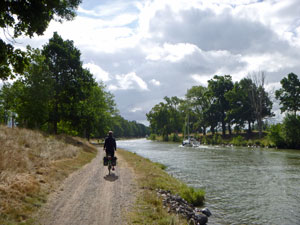 Back on the Gota Canal towpath |
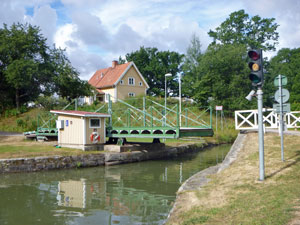 A retractable canal bridge |
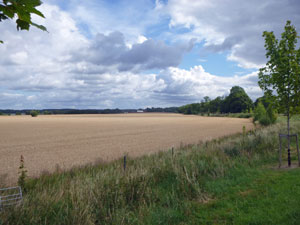 Rural land alongside the canal |
The route this morning was entirely along the canal - thus, we pottered along its different reaches, some passing through open farmland, some through forest groves, one along and above Norbysjon, a pretty reed-lined lake at the edge of the forest, and twice we crossed high over a large highway - both us on our bikes and the Gota Canal. |
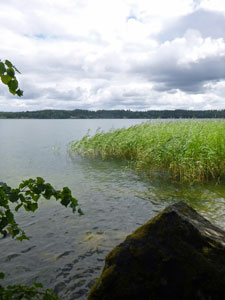 Reed-lined Lake Norbysjon |
Several large yachts, a couple of power cruisers and one large tourist cruise ship swept slowly by as we rode, rippling the banks with their bow waves. I wonder whether Baron von Platen had any inkling that he was creating a pleasure canal when he built it to avoid Danish taxes in the strait to the south. |
|
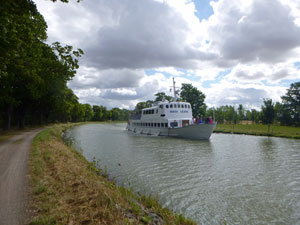 A Gota Canal "cruise ship" ..... |
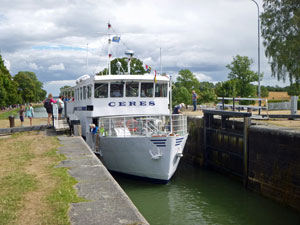 ... followed by another - a tight fit in the lock |
|
Finally we reached the houses of Ljungbro, where the canal began to take on a much more manicured and park-like appearance. The terrain was starting to fall away towards Rosken Lake as we passed a couple of double locks and a broader section where boats could moor, possibly to wait their turn at the famed Berg locks - a series of seven locks that lift the level of the canal 19m above Lake Rosken. In no time at all, we had reached the top of the locks, looking down over the herring bone of lock gates to the wind-whipped waters of the lake beyond. |
|||
 The locks of Berg |
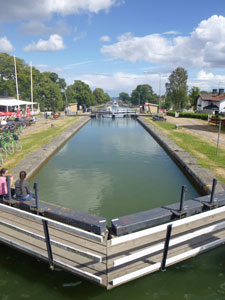 Looking back up-canal from a lock |
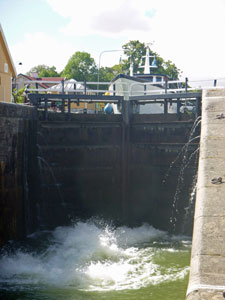 The lock begins to empty |
 Yachts climbing up the Berg lock ladder |
Now, from Berg the cycle route would normally have been a 35 km push around the hills of the northern shore of Lake Rosken to the town of Norsholm, our destination for the day. Given my current state of chronic dehydration and the cramping incident of yesterday, this seemed silly. Moreover, our shopping bikes were simply not up to it. Luckily, we had a Plan B to work to, and that involved making a reservation on the RoxenSnabben, a lovely name for what would turn out to be a small flat-bottomed fishing boat that could ferry up to eight people and their bikes along the 25 km length of the lake to Norsholm. |
We arrived at 12.30pm and RoxenSnabben left at 4pm, but the Berg Locks are a place where it is easy to wile away the time. So, finding the local ICA nearby, we bought the wherewithall for a nice lunch watching the rise and fall of yachts and big ships in the locks. All the time the sun was winning the sky back. Then we gradually descended the tiers of the lock system, having a coffee here and an ice-cream there. Pretty soon, we were at the lake shore waiting on the pier and right on time, the RoxenSnabben arrived. |
||
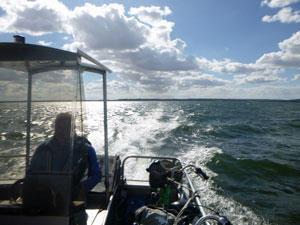 Crossing Lake Roxen |
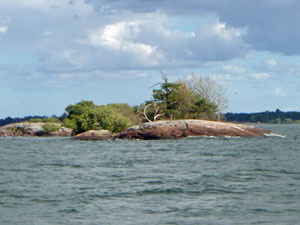 A rocky islet in the lake |
 RoxenSnabben arriving at Norsholm |
We loaded the bikes along with our fellow passengers, a very pleasant couple from Stockholm, and set off for the one-hour trip to Norsholm. What a great trip it was. RoxenSnabben was a speedy little vessel and soon we were powering eastwards across the dark white-capped waters of the lake, with the wind at our back and nice rooster-tailed wake. We were running with the wind waves, almost surfing at times, big splashing thumps at others. What a shame that all the big yachts seem to cross here on motor alone, without setting sail - the conditions today were made for sailing. Eventually, we left the main body of the lake behind, entering a long, more protected reach, dotted with low rocky islets and their colonies of gulls and cormorants. Finally, houses appeared ahead - we were at Norsholm and were soon entering the Gota Canal itself. However, just inside, RoxenSnabben pulled into shore and we all disembarked. It had been a great way to get here. |
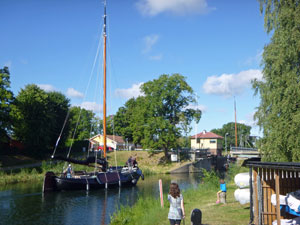 A replica 19th century Dutch riverboat |
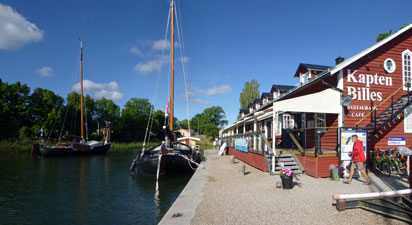 Kapten Billes - our accommodation in Norsholm |
Our accommodation, Kapten Billes Hostel, was only a few hundred metres further along on the shore of the canal. What better way to finish the day than, after a nice hot shower, sit on the deck of Kapten Bille and sip a cold Swedish beer. |
|
|
Day 3 - Norsholm to Söderköping (26 km) |
We would have perfect riding weather for our last day on the Gota Canal - the sky was clear blue with a few puffy white clouds and the wind of yesterday had faded to a gentle breeze. After a hearty breakfast provided by Kapten Bille, we set out, crossing the bridge to the southern side of the canal and resuming our easterly doddle. |
||
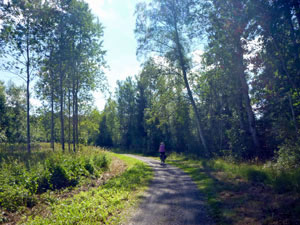 Shady path out of Norsholm |
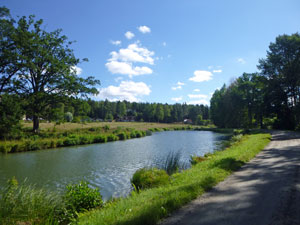 Back alongside the canal |
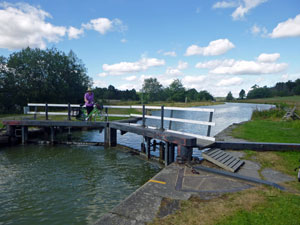 Crossing the canal by a lock |
Similarly to yesterday, we found ourselves passing through a mix of forest and farmland, past several canal fishermen practicing for a competition, and out to the Hurta Lock and the western end of Asplangen Lake. To the north, the forested hills rose steeply from the lake shore - this was our new direction, following a gravel forest road that climbed up into the mixed conifer and broadleaf forest, before meandering across towards the village of Snoveltorp at the eastern end of the lake. |
|
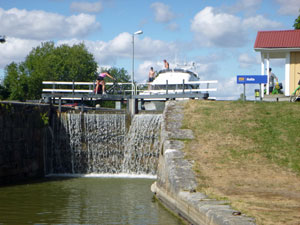 Boat arriving at a lock |
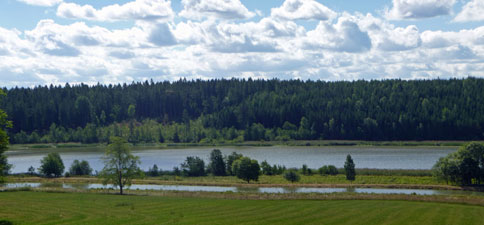 Gota Canal flowing past Lake Asplangen |
It made for a nice change to ride through the forest, dark and dense in parts, airy in others, but with that rich resinous scent of pines that stimulates the senses. It was also hard work on our undergeared bikes and, for the first time since leaving home, we got the equivalent of our weekly workout at the gym - something our bodies needed. |
 |
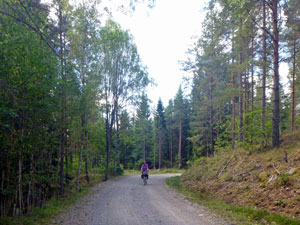 In the forest of Asplangen |
 |
From Snoveltorp, we rejoined the Gota Canal for its final run into Söderköping. The first part of the canal here was in some ways the nicest, a little less contrived as it wended its way between hills on either side with overhanging branches and semi-submerged plants fuzzing the artificially straight edges. It was my favourite part. |
||
 |
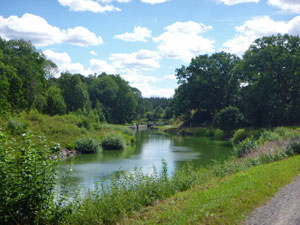 The canal between Snoveltorp and Söderköping |
 |
Passing through more rural land, with fields of wheat and oats, we passed our last series of locks to reach the outskirts of Söderköping. A large influx in the number of tourists wandering along the canal's edge and a long line of moored yachts told us we had arrived. It was time to dismount and walk our bikes, stopping briefly for coffee and cake to mark the end of the ride. |
||
|
We enjoyed the sun and the passing parade until 2pm, check-in time at nearby Korskullen's Camping, when we rode the last few hundred metres to our home for the night and a reunion with the rest of our luggage.
|
|
Home was indeed the same quaint little wooden cabin as before, with its little wooden deck, where we could sit and reminisce upon our three days on Sweden's famous Gota Canal. |
|







